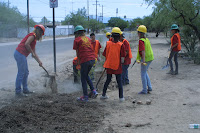Harvesting Rainwater (if it ever rains!) at Barrio Kroeger Lane
 I'm back from another morning at Barrio Kroeger Lane with the Southwest Conservation Corps. We have their teams of middle school students--part of a "learn and serve" summer program--creating rainwater harvesting basins along the often-flooded streets of this small neighborhood southwest of downtown Tucson.
I'm back from another morning at Barrio Kroeger Lane with the Southwest Conservation Corps. We have their teams of middle school students--part of a "learn and serve" summer program--creating rainwater harvesting basins along the often-flooded streets of this small neighborhood southwest of downtown Tucson.My back is a little sore this time because a coupler was misplaced that allows them to get water from an irrigation system there. So I had to make three trips with a 55-gallon barrel in the back of my truck to ferry water to them, which we then had to dip out of the barrel with 5-gallon buckets to water the plants.
Glitches are to be expected in a project this big, and that has so many partners. Tucson Audubon's participation is paid for by our TogetherGreen Innovation Grant, a program of National Audubon funded by Toyota. This is the second year we have been working with this neighborhood with TogetherGreen funds. Additional funding was obtained by City Council member Regina Romero's Ward 1 council office, through the efforts of Mac Hudson, aide to the council member. This money has paid for the City of Tucson Department of Transportation to do the initial, rough excavation of the extensive rainwater harvesting basins, and to cut the curbs to allow stormwater to run into the basins from the street.

The Barrio Kroeger Lane Neighborhood, of course, is providing the pallet for this work and some great logistical assistance.
Desert Survivors Nursery, located nearby on Starr Pass Road, pitched in by providing trees and shrubs at a discount. Finally, the Southwest Conservation Corps obtained their Learn and Serve Grant and decided to use a substantial amount of the available student labor to help build these basins.
The Learn and Serve students have been shaping basins, lining them with rock, planting trees and shrubs and putting mulch in the basin (as seen in the adjacent photo). Tucson Audubon has provided our staff time to oversee the work, some of the mulch and many of the shrubs.
The project addresses several ecological and practical issues. First, the neighborhood is on flat ground in the historic floodplain of the Santa Cruz River, and is subject to flooding in heavy summer rains. The project will help reduce the amount of stormwater on streets, which will flow off the streets through the cuts in the curbs and into the basins. Second, the stormwater will help grow native tree and shrub species that will beautify the neighborhood and provide homes for birds and other animals. Third, this is a demonstration of how landscaping can subsist on rainwater alone (after plants are established), reducing the amount of expensive and scarce potable water we have to use on landscapes. This will eventually help us to reach groundwater safe yield, protect areas of high groundwater, and perhaps take less water from the Colorado River. Our use of Colorado River water kills habitat along the lower Colorado River, uses huge amounts of energy and has a huge carbon footprint.
So hooray for all who are participating in this great effort! And I'll rest my back the rest of the day.
Comments
Post a Comment
Thanks, we value your opinions! Your comment will be reviewed before being published.